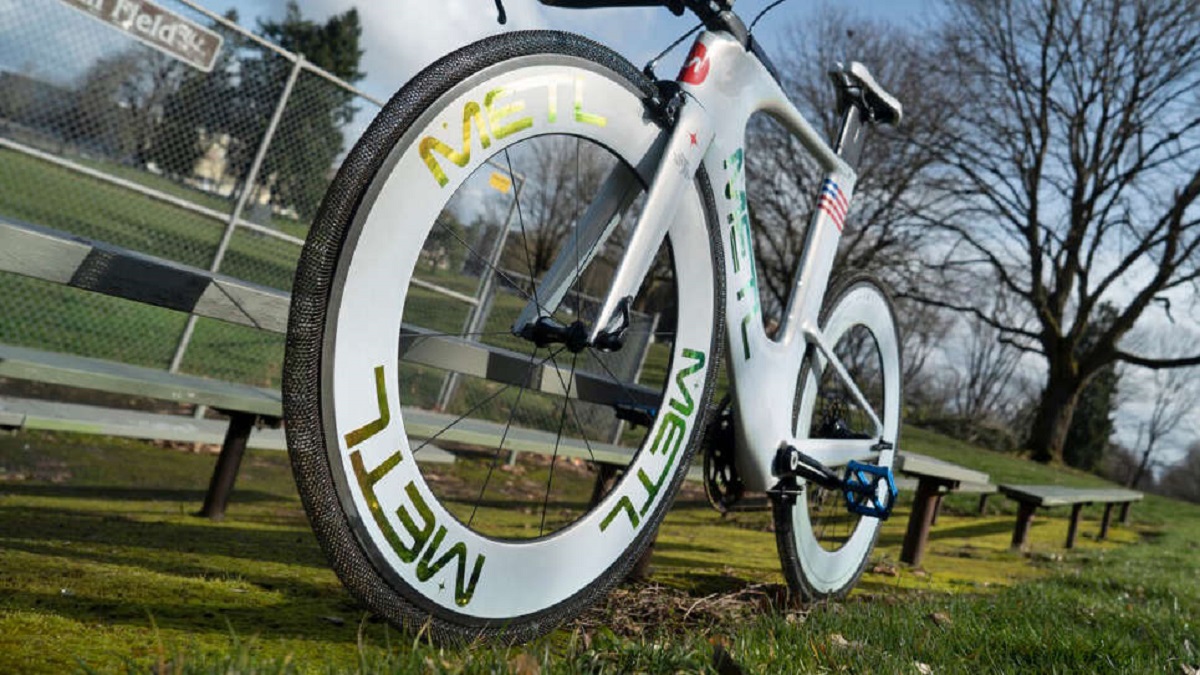
The technology that will allow rovers on Mars to roll on the Martian soil could offer bicycles on earth an airless alternative to traditional rubber tires. A newly developed nickel-titanium alloy shape memory tire called METL is supposedly “elastic-like rubber yet strong like titanium”.
The Smart Tire Company is attempting to commercialize airless tires for bicycles. These advanced and lightweight wheels ditch synthetic rubber, but not entirely. A tire that never needs air sounds like a good idea but there are practical limitations and challenges.
Smart has licensed airless tire technology from NASA developed for Mars exploration:
The Martian environment is harsh. It is simply too cold for traditional rubber tires. On the other hand, the solid aluminum tires used on Curiosity were prone to cracking.
Innovators presented mesh tires as a possible solution. The Spring Tire in the mid-2000s that used coiled steel wires woven into a mesh pattern, was the inspiration.
However, instead of springs, an interwoven mesh of strands made from nickel-titanium alloy was a good solution.
NASA engineers adapt airless lunar tires for bikes using "Metl" = rubber coated interconnected nickel-titanium springs. Wow! pic.twitter.com/79D6GynMNY
— Fastfitness.Tips (@fitnessradar) March 17, 2021
The final design of the tire looks like chainmail. However, it remembers its shape and returns to it after an impact.
Under the Space Act Agreement, the Smart Tire Company has licensed the technology. It now wants to make airless tires from nickel-titanium alloy for bicycles.
The first product is called METL and it is made from NiTinol+. It is a road cycling tire first. However, the company claims cyclists can use the tires for mountain bikes, gravel bikes, and road bike applications in the future.
SMART startup is developing airless METL bicycle tires based on the shape memory alloy tech for NASA's planetary rovers.
SMA tires of interconnected springs don't need air, are immune to punctures, amd provide good traction and some shock-absorption.
(TC) https://t.co/tOsIbFbPRG pic.twitter.com/GhHpCVnXWx— Steven Ashley (@steveashleyplus) March 17, 2021
The designers have ensured the METL tire conforms to the ground in a similar fashion to a pneumatic tire. However, being airless and made of metal, there are no punctures. Moreover, the makers claim their tires last way longer than traditional tires made from synthetic rubber.
Speaking of synthetic rubber, the Smart Tire company also stresses the environmental benefits of ditching the material. They claim the tire industry produces about 25 million tons of toxic waste annually, and NiTinol+ is a much cleaner alternative.
What are the challenges and limitations of ‘METL’ metallic airless tires for bicycles?
The Smart tire company assures METL is “competitive with many mainstream alternatives”. Moreover, the rolling resistance is supposed to be similar to a pneumatic tire pumped to 100 PSI.
Additionally, the company will reportedly coat the tires, “in a new, formulated rubber-like material, Polyurethanium, for the longest-lasting tread and grip, for all weather conditions”. The company claims this will add grip and make them suitable for riding on all terrains, including pavement, gravel, and dirt.
Hey yo Joe (Biden) can I get maybe ten more of them checks? I need this for the bike I ride once a year:https://t.co/AsSndP8VLP#biking #nasa #METL #nitinol
— Jason Edwards (@bukkhead) March 17, 2021
The soft material should wear out, but it can be reapplied. Hence, the life of the tire is significantly more. Moreover, this significantly reduces the number of tires that end up in landfills.
Incidentally, the METL tires, being made from a metallic alloy, will certainly be heavier than traditional tires. Hence, they might not be suitable for professional cyclists and athletes. However, casual users, as well as mountain-bike users, could use them with ease.
There’s no confirmed information about the price and commercial availability of METL tires made from NiTinol+. The company does, however, offer an extensive FAQ to understand the science and benefits.


